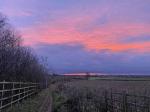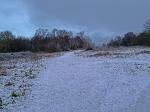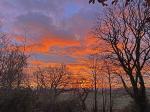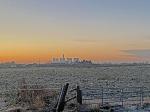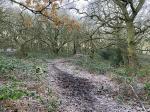Brayton Barff Through the Seasons.
Set in the Vale of York, South West of the market town of Selby and between the villages of Thorpe Willoughby and Brayton, lies Brayton Barff, a sandstone Hill approximately one hundred and fifty feet in height which was formed by glacial movement during the last Ice Age. It is a significant landmark in an otherwise flat landscape.
Today the site is primarily owned by Yorkshire Water with Selby District Council owning a small patch of the land adjacent to the A63 Selby bypass. A large underground reservoir occupies the centre of the site which delivers water to around 4.7 million customers throughout Yorkshire.
Within the Barff woodland over 40% of the trees are Sessile Oak which are generally found in semi natural woodlands in the north of the country. These trees are so called because its acorns are not held on stalks, like those of the English Oak (Pedunculate), but attached directly to the outer twigs. There are also several English Oak trees as well as some cross-hybrid oaks. These trees are known to support many species of flora and fauna, invertebrates, mosses, lichen and fungi.
During the Victorian times it is thought that the shipbuilders on the east coast would come over to the Barff for selected cuts of timber to build their sea going vessels.
The Barff also has a variety of other trees including Silver Birch, Beech, Sycamore, Holly, Rowan, Scots Pine, Alder, Hawthorne and European Larch. There are also several Yew, Willow, Hazel, Horse Chestnut and Wych Elm. As with similar woodlands there are a variety of bushes, including Honeysuckle, Elderberry, Gorse, Broom and Buddleia.
The history of Brayton Barff is quite vague, apparently during 1803 a beacon was lit on the Barff when the country was threatened with an invasion by Napoleon. In May 1935, to celebrate King George V's Silver Jubilee, a Bonfire was lit on the Barff as part of the celebrations.
Early issues of Ordnance Survey Maps dated 1903 clearly show a rifle range on the Barff, extending out to Mill Lane. During the 
Between 2001 – 2004 the A63 Selby bypass, 10km twin lane single carriageway was constructed which severed the South West corner of the Barff, adjacent to Selby Golf Course and resulted in a slight redesign of several holes on the golf course. Wooden fencing was erected as a result of this new road running alongside of the Barff and a footbridge constructed over the ‘new road’ following the line of the Bridal way which extends from Mill Lane. Around 2005/2006 a definite 2metre wide limestone aggregate footpath was laid forming a circular path around the outer edges of the woodland. This footpath is approximately 1.2 miles in length and takes about 30 minutes to circumnavigate at a leisurely pace.
In 2012 the Barff was declared an Ancient Oak Woodland and as such throughout 2012 and 2013 significant work had been carried out by the relevant agencies to cut and remove large swathes of non-native trees, creating at that time huge scars on the landscape. Some three years later the planting of the native trees have become well established and are flourishing. Ongoing maintenance work on the footpath around the bottom of the Barff was completed during the Summer of 2016.
A second phase of woodland maintenance commenced during the Autumn of 2019 with the removal of many old and diseased trees and the cutting back of the Gorse and Broom bushes, especially adjacent to the ‘bypass trail’, this work continued through till March 2020 with re planting continuing into April 2020.
Brayton Barff is a popular site for walkers and bird watchers alike and a path circling the outer perimeter of the Barff makes a pleasant thirty minute walk, giving views looking over towards Selby and the village of Brayton as well as the power stations of Drax and Eggborough..jpg)
For the early risers it is a great place to see some stunning sunrises over the villages of Brayton looking towards Drax Power Station, the same with the Sunsets looking over towards Eggborough and Monk Fryston.
The Barff changes with the Seasons and every visit can reveal something new, the woodland is a haven for wildlife. Records show that since 1982 one hundred and twelve species of bird have been seen in the woodland and at least 40 of those have bred here, including Tawny Owl, Buzzard, Green Woodpecker, Spotted Flycatcher, Goldcrest and Nuthatch to name just a few. On average over 70 species of bird are recorded each year. Further details of the bird life on the Barff can be found on the Brayton Barff Group Facebook page, especially the posts from Derek Cooper. Today ‘The Friends of Brayton Barff group’ led by Derek and a small team of volunteers help keep and maintain the cleanliness of the site as well as recording the wildlife and bird sightings.
The Barff is also home to fifteen different species of mammals, including Muntjac Deer, Pipistrelle Bat, Fox, and Field Vole.
Over eighty species of plant and wildflowers have been recorded, included Bee Orchid, Northern Marsh Orchid, Wood Anemone, Marsh Ragwort, Bluebell, White Bluebell, Bittersweet and Purple and White Foxgloves. Over twenty species of Butterfly have been recorded, including Marbled White, Brown Angus, Speckled Wood, Comma and Brimstone.
During the Autumnal months fungi thrives in this woodland environment, species including Fly Agaric, Beefsteak Tree Fungi, Chicken of the Wood, Sulphur Tufts, Stinkhorn, Ink cap, Puffballs and Hoof Bracket are just some of the many varieties that can be found here.
Click on the galleries shown below to expand the albums.
December 2020
What a month.
Alas, December has brought shorter days, darker mornings and much colder and wetter weather, I have had to resort to wearing my wellies for our dog walks on the Barff, as most of the tracks away from the main perimeter footpath are extremely muddy and have been for the whole of December.
The Covid pandemic continues apace across the country, fortunately here in our part of North Yorkshire we are still in Tier 2, though West Yorkshire and the East Riding have just moved into Tier 3 since Christmas.
Life on the Barff continues as usual, though the bird life seems to have quietened down considerably with most of our summer visitors now left the area for warmer climes before returning again in the Spring.
There are plenty of Grey Squirrels about, they don’t really hibernate through the winter and can be seen on most visits to the Barff, they will have stockpiled a significant amount of food, including an abundance of Acorns, to get them through the cold, wet winter months. As much as I would sooner see the Red Squirrels the Greys are quite characters and I often have to stop and watch as they busily scurry up and down the tree trunks at breakneck speed chasing their brothers and sisters, they are extremely light footed and agile, the noise they make sounds like that of snowflakes landing on a window during a cold winters blizzard.
The Buzzards are still around the Barff area, I have heard a pair calling several times a week on my morning walks around the woodland mainly on the other side of the bypass adjacent to the golf course.
I often seem to disturb hen and cock pheasants on my early morning walks, they are lovely, big and colourful birds but a bit skittish, quite occasionally jumping out in front of me with a lot of wing flapping and squawking, if they just kept their heads down, I would have walked past them completely oblivious of them ever being there.
December has been an exceptionally wet month in this part of Yorkshire, just before Christmas the volume of water in the Aire & Calder caused it to breach its banks causing considerable flooding around East Cowick, fortunately most of the water drained into agricultural land on the South side of the M62.
‘Storm Bella’ hit the country on Boxing day evening, fortunately this part of the county escaped the worst of the wind and rain although we had in excess of 15mm of rain fall overnight. The River Ure in the Yorkshire dales over topped again around Hawes which caused significant flooding albeit on agricultural land but also caused problems shutting the A684 at Wensley.
The dull and cloudy mornings in December were occasionally replaced with several frosty mornings which, although cold, made quite a pleasant change, as did some of the sunrises, the sun was rising at about 8.00am at the beginning of the month and 8.30am towards the end of December, which made for some spectacular skies looking over towards the East and the villages of Brayton and further afield Drax, unfortunately within a 15-minute window the sun had disappeared behind thick dense cloud.
Although relatively quiet on the bird front on the Barff at the moment, we still have our residents, Blue and Great Tits, Nuthatch, Robin, Goldcrest, Chaffinch, Dunnocks and Wrens which can be heard around and amongst the woodland.
It was several years ago that the Barff was designated an Ancient Oak woodland, and following an recent investigation by one of our ‘friends of Brayton Barff, Derek Cooper armed with a long tape measure has measured a number of our significant Oak trees on the Barff. It was interesting to note that one of one of the oldest trees is the ‘Oak swing tree’ which most youngsters and their parents will know on the eastern side of the Barff, this tree measures around 6 metres around its circumference which puts it date at approximately 433 years old. To put this into some form of prospective, at the time this Oak tree was planted during the 1580’s, Queen Elizabeth 1 was on the throne, Mary Queen of Scots was beheaded, William Shakespeare married Anne Hathaway and Francis Drake was knighted. It will be fascinating to see if Derek finds any trees older than this one on the Barff.
During the last week of December, we saw our first snow of the winter, it had been snowing quite heavily earlier in the day on Monday 28th in parts of West Yorkshire and the Dales but it wasn’t until the early hours of Tuesday 29th that it reached the Barff area. By 7.30am it had all but stopped and we were left with a covering of wet slushy snow. The weather still stayed cold though, and we have just experienced three bitterly cold days were the temperature didn’t get much above 4C during the day, dropping to -4C during the night. The hard penetrating frost of the 30th finally froze the mud on the woodland trails making them firmer to walk on, that said the main perimeter footpath became quite treacherous in places due to the ice, fortunately by late morning the sun and slightly warmer temperature made the paths much less slippy.
Unfortunately, as the month comes to an end, cases of Covid continue to rise again across much of the country with many counties now being placed into a tier 4, fortunately North Yorkshire has been placed in tier 3, so at least we are still able to come to the Barff to walk and exercise.
Finally, to end on a more pleasant note, the days are now starting to get a little longer, it is beginning to get light at around 7.30am and am pleased to report that tiny Bluebell shoots are just starting to poke through the ground, role on Spring.
|

